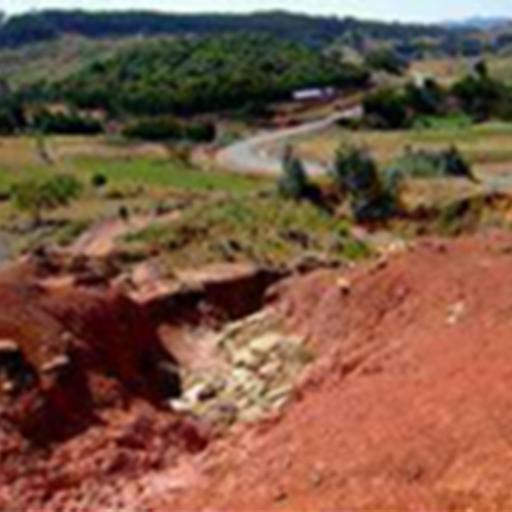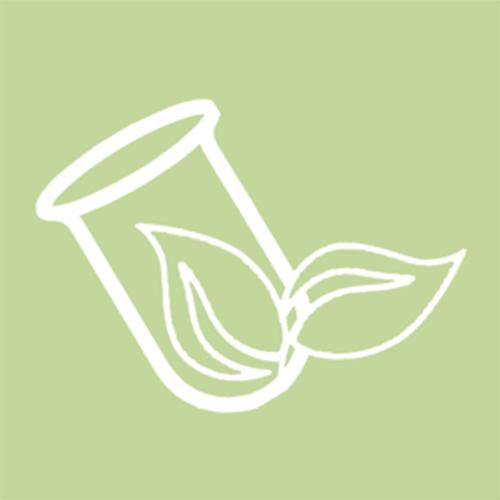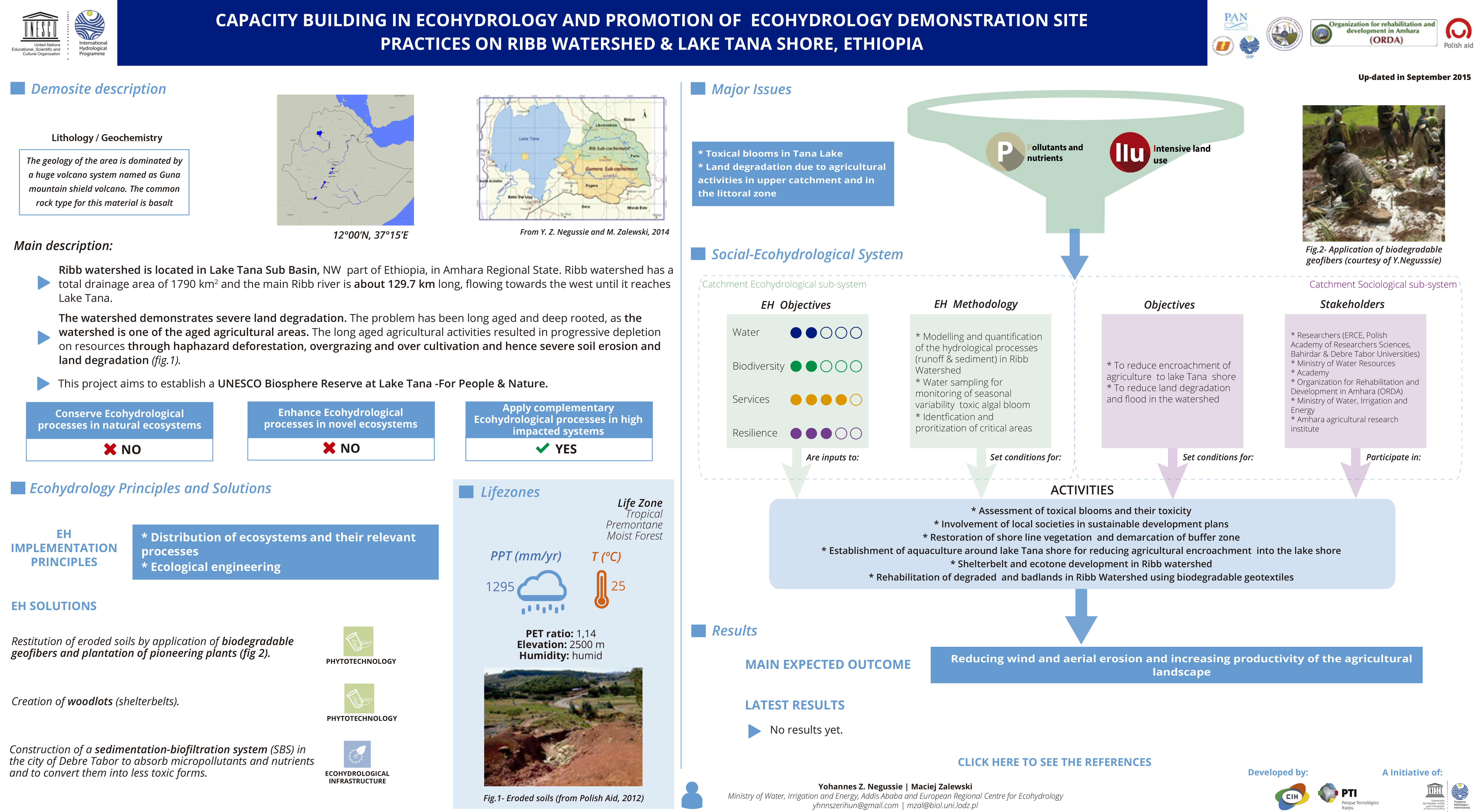CAPACITY BUILDING IN ECOHYDROLOGY AND PROMOTION OF ECOHYDROLOGY DEMONSTRATION SITE PRACTICES ON RIBB WATERSHED & LAKE TANA SHORE




Description
Location


Sketch

Information about lithology/geochemistry:
The geology of the area is dominated by a huge volcano system named as Guna mountain shield volcano. The common rock type for this material is basalt
Main Description
- Ribb watershed is located in Lake Tana Sub Basin, NW part of Ethiopia, in Amhara Regional State. Ribb watershed has a total drainage area of 1790 km² and the main Ribb river is about 129.7 km long, flowing towards the west until it reaches Lake Tana.
- The watershed demonstrates severe land degradation. The problem has been long aged and deep rooted, as the watershed is one of the aged agricultural areas. The long aged agricultural activities resulted in progressive depletion on resources through haphazard deforestation, overgrazing and over cultivation and hence sever soil erosion and land degradation.
- This project aims to establish a UNESCO Biosphere Reserve at Lake Tana -For People & Nature.
Enhance ecohydrological processes in novel ecosystem
NO
Apply complementary Ecohydrological processes in high impacted system
YES
This table presents the different categories of ecosystem services that ecosystem can provide, divided in:
Provisioning Services are ecosystem services that describe the material or energy outputs from ecosystems. They include food, water and other resources.

Food: Ecosystems provide the conditions for growing food. Food comes principally from managed agro-ecosystems but marine and freshwater systems or forests also provide food for human consumption. Wild foods from forests are often underestimated.

Raw materials: Ecosystems provide a great diversity of materials for construction and fuel including wood, biofuels and plant oils that are directly derived from wild and cultivated plant species.

Fresh water: Ecosystems play a vital role in the global hydrological cycle, as they regulate the flow and purification of water. Vegetation and forests influence the quantity of water available locally.
Regulating Services are the services that ecosystems provide by acting as regulators eg. regulating the quality of air and soil or by providing flood and disease control.

Local climate and air quality: Trees provide shade whilst forests influence rainfall and water availability both locally and regionally. Trees or other plants also play an important role in regulating air quality by removing pollutants from the atmosphere.

Carbon sequestration and storage: Ecosystems regulate the global climate by storing and sequestering greenhouse gases. As trees and plants grow, they remove carbon dioxide from the atmosphere and effectively lock it away in their tissues. In this way forest ecosystems are carbon stores. Biodiversity also plays an important role by improving the capacity of ecosystems to adapt to the effects of climate change.

Moderation of extreme events: Extreme weather events or natural hazards include floods, storms, tsunamis, avalanches and landslides. Ecosystems and living organisms create buffers against natural disasters, thereby preventing possible damage. For example, wetlands can soak up flood water whilst trees can stabilize slopes. Coral reefs and mangroves help protect coastlines from storm damage.

Erosion prevention and maintenance of soil fertility: Soil erosion is a key factor in the process of land degradation and desertification. Vegetation cover provides a vital regulating service by preventing soil erosion. Soil fertility is essential for plant growth and agriculture and well functioning ecosystems supply the soil with nutrients required to support plant growth.
Ecosystem services "that are necessary for the production of all other ecosystem services". These include services such as nutrient recycling, primary production and soil formation.
Cultural Services corresponds nonmaterial benefits people obtain from ecosystems through spiritual enrichment, cognitive development, reflection, recreation, and aesthetic experiences.

Recreation and mental and physical health: Walking and playing sports in green space is not only a good form of physical exercise but also lets people relax. The role that green space plays in maintaining mental and physical health is increasingly being recognized, despite difficulties of measurement.

Tourism: Ecosystems and biodiversity play an important role for many kinds of tourism which in turn provides considerable economic benefits and is a vital source of income for many countries. In 2008 global earnings from tourism summed up to US$ 944 billion. Cultural and eco-tourism can also educate people about the importance of biological diversity.

Aesthetic appreciation and inspiration for culture, art and design: Language, knowledge and the natural environment have been intimately related throughout human history. Biodiversity, ecosystems and natural landscapes have been the source of inspiration for much of our art, culture and increasingly for science.
Lifezones

![]()
PPT(mm/yr): 1295.0
![]()
T(ºc): 25.0
| Elevation of demosite: | 2500.0 meters above sea level |
| Humidity: | Humid |
| PETr (by year): | 1.14 |
EH Principles
Quantification of the hydrological processes at catchment scale and mapping the impacts
Ecological engineering (integration, dual regulation and biotechnologies in catchment scale for enhancement of ecological potential)
ECOHYDROLOGY ENGINEERING SOLUTIONS
Restitution of eroded soils by application of biodegradable geofibers and plantation of pioneering plants.
 Phytotechnology
Phytotechnology
Creation of woodlots (« shelterbelts »).
 Phytotechnology
Phytotechnology
Construction of a sedimentation-biofiltration system (SBS) in the city of Debre Tabor to absorb micropollutants and nutrients and to convert them into less toxic forms.
 Ecohydrological Infrastructure
Ecohydrological Infrastructure
Major Issues
- Toxical blooms in Tana Lake.
- Land degradation due to agricultural activities in upper catchment and in the littoral zone (fig.2).




Expected Outcomes
Reducing wind and aerial erosion and increasing productivity of the agricultural landscape.
Latest Results
- No results yet.
Contacts
Yohannes Z. Negussie
- yhnnszerihun@gmail.com
- http://www,mowr.gov.et
- Ministry of Water, Irrigation and Energy, Addis Ababa
- http://www,mowr.gov.et

Social ecohydrological system
EH Objectives
EH Methodology
Catchment Ecohydrological sub-system
Objectives
Stakeholders
Catchment Sociological sub-system
Activities